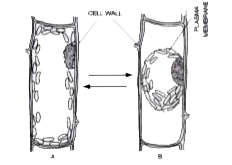If a cell is viewed under low power and them under high power , and no fine adjustment is necessary to see it clearly , the microscope is considered
parfocal
bifocal
achromatic
apochromatic
The correct Answer is:A
To solve the question regarding the type of microscope that allows viewing a cell clearly under both low and high power without the need for fine adjustment, we can follow these steps:
1. Understanding the Question: The question asks about a microscope that allows clear viewing of a specimen under different magnifications (low and high power) without needing to adjust the focus.
2. Identifying Key Terms: The terms "parfocal," "bifocal," "achromatic," and "apochromatic" are crucial to understanding the types of microscopes.
3. Defining Parfocal: A parfocal microscope is designed such that when you switch from one objective lens to another, the specimen remains in focus. This means that little to no fine adjustment is needed when changing magnifications.
4. Examining Other Options:
- Bifocal: This term typically refers to lenses that have two different optical powers, but it does not specifically relate to microscope functionality in maintaining focus.
- Achromatic: This type of lens reduces chromatic aberration but does not guarantee that the focus will remain when switching lenses.
- Apochromatic: Similar to achromatic, but designed to bring three colors into focus, it does not imply that the focus remains unchanged when switching lenses.
5. Conclusion: Since the question specifies that no fine adjustment is necessary when switching from low to high power, the correct answer is parfocal.
Final Answer:
The microscope is considered parfocal.
---
- Bifocal: This term typically refers to lenses that have two different optical powers, but it does not specifically relate to microscope functionality in maintaining focus.
- Achromatic: This type of lens reduces chromatic aberration but does not guarantee that the focus will remain when switching lenses.
- Apochromatic: Similar to achromatic, but designed to bring three colors into focus, it does not imply that the focus remains unchanged when switching lenses.
The microscope is considered parfocal.
Similar Questions
Knowledge Check
An under-water swimmer cannot see very clearly even in absolutely clear water because of
Aabsorption of light in waterBscattering of light in waterCreduction of speed of light in waterDchange in the focal length of eye lens
When a colloidal sol is observed under a microscope we can see,
View SolutionWhen a colloidal sol is observed under a microscope we can see,
View SolutionCondensation of chromosomes is completed and can be observed clearly under microscope during
View SolutionJG cells, under low glomerular blood flow release
View SolutionGiven below are diagrams of plant cells as seen under the microscope after being placed in two different solutions :

Under what conditions in the soil will root hair cell resemble : (1) Cell A (2) Cell B?
View SolutionName the scientist who coined the term "cell". How many lenses did he use in his microscope ? What did he observe under his microscope ?
View SolutionWhen an object is viewed with a light of wavelength 6000Å under a microscope, its resolving power is 104. The resolving power of the microscope when the same object is viewed with a light of wavelength 4000Å, is n×103. The vlaue of n is
View Solution
